Download PDF
Download page Selecting a Snowmelt Method.
Selecting a Snowmelt Method
Precipitation generally occurs as snow when the air temperature over the land surface is below the freezing point. In general the snow will accumulate on the land surface so long as the air temperature remains below the freezing point. In some watersheds it is part of the annual hydrologic cycle that snowfall accumulates in a snowpack during the winter months. Snow packs are not static but undergo continual ice crystal transformations in response to diurnal temperature fluctuations. Ablation or melting of the snowpack occurs when atmospheric conditions transfer energy sufficient to raise the temperature of the snowpack to the freezing point, and then transform the snow to liquid water through the heat of fusion for ice. The most common way to measure the water content of the snowpack is by the Snow Water Equivalent or SWE. The SWE is the depth of water that results from melting a unit column of the snowpack.
The Snow Method included in the Basin Model is only necessary when the air temperature may be below the freezing point during a simulation, or a snowpack may exist at the beginning of a simulation. Currently the only option available is a Temperature Index approach that includes a conceptual representation of the snowpack energy. It computes the liquid water available at the soil surface which is then subject to infiltration and surface runoff.
Gridded Temperature Index
The Gridded Temperature Index Method is the same as the Regular Temperature Index Method except the equations for simulating the snowpack are computed separately for each grid cell with separate precipitation and temperature boundary conditions instead of area-averaged values over the whole subbasin. Starting in v4.12, this method can be used in conjunction with any precipitation, temperature, and/or land surface method.
The Gridded Temperature Index Method includes a Component Editor with snow pack initial conditions and temperature index parameters for an individual subbasin element, as shown in the following figure. You can open a global temperature index editor from the Parameters | Snowmelt menu.
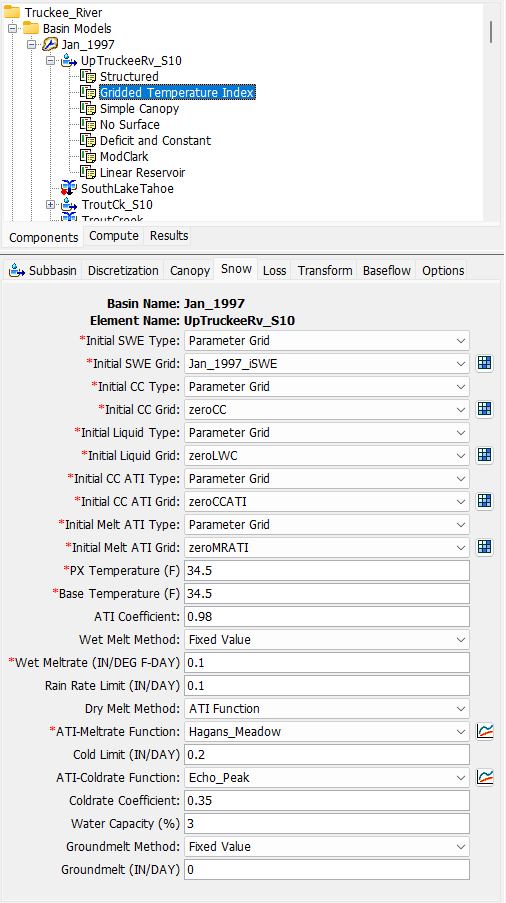
Initial Values
Each of the five state variables can be individually set to a distinct method for setting the initial values. The Initial Values can be specified with gridsets, default values or a user-specified constant value. All cells in each subbasin are set to the same default value or constant value when the Default Value or Constant Value options are chosen. The default values are:
- Initial SWE of 0 mm
- Initial Cold Content of 0 mm
- Initial Liquid of 0%
- Initial Cold Content ATI of 0° C
- Initial Meltrate ATI of 0 DegC-day
Five parameter grids must be selected when the Parameter Grids option is selected; the grids are described in the following paragraphs.
The Initial Snow Water Equivalent that exists at the beginning of the simulation must be entered. This information is usually determined by interpolating from actual measurements of snow water equivalent. This value can be set to zero if there is no snow.
The Initial Cold Content that exists at the beginning of the simulation must be entered. It represents the heat required to raise the temperature of the snow pack to 0° C (32° F) and is expressed as a number equivalent to mm (inches) of frozen water. If there is no snow at the beginning of the simulation, it can be set to zero. If there is a snowpack, it can be estimated as the depth of snow multiplied by the snow density multiplied by the heat capacity of snow multiplied by the number of degrees below the freezing point.
The Liquid Water Held Within the Snowpack at the beginning of the simulation must be entered. Liquid water can persist in the snow only if the snowpack temperature is at 0° C (32°F). There are few conditions when this value can be exactly known. One case is when there is no snowpack and it can be set to zero. A second case is when the air temperature has been continually below freezing for several days and it can be set to zero.
The Initial Cold Content Antecedent Temperature Index is an index to the snow temperature near the surface of the snowpack. It should be set to the approximate snowpack temperature at the beginning of the simulation. If the initial temperature is not known, it can be set to 0° C (32° F).
The seasonal variation of meltrate is indexed by an Antecedent Temperature Function. The initial meltrate ATI should be thought of as similar to "the accumulated thawing degree days." If there is no snow on the ground at the start of the simulation this term can be set to zero. It can also be set to zero if the simulation is starting during or at the end of a cold period when air temperatures were continually below the base temperature. Otherwise it must be calculated as the accumulation of degree-days since the last period of sustained air temperature below freezing.
Parameter Values
The PX Temperature is used to discriminate between precipitation falling as rain or snow. When the air temperature is less than the specified temperature, any precipitation is assumed to be snow. When the air temperature is above the specified temperature, any precipitation is assumed to be rain. This discrimination temperature may be up to 1° C.
The difference between the base temperature and the air temperature defines the Temperature Index used in calculating snowmelt. The meltrate is multiplied by the difference between the air temperature and the base temperature to estimate the snowmelt amount. If the air temperature is less than the base temperature, then the amount of melt is zero. Typically, the base temperature should be 0° C.
The Wet Meltrate is used during time intervals when precipitation is falling as rain, and the rainfall rate is greater than the rain rate limit. It represents the rate at which the snowpack melts when it is raining on the snowpack.
There are two options for specifying the Wet Meltrate:
- Fixed Value. A fixed value is used to calculate the wet meltrate.
- Annual Pattern. A meltrate pattern may be specified that defines the wet meltrate as a function of the time of year. The pattern must be specified separately in the Paired Data Manager before it can be used in the Snow Melt Method. The Paired Data Type should be Parameter Value Pattern with parameter Wet Melt Rate.
The Rain Rate Limit discriminates between dry melt and wet melt. The wet meltrate is applied as the meltrate when it is raining at rates greater than the rain rate limit. If the rain rate is less than the rain rate limit, the meltrate is computed as if there were no precipitation. The default value of 0 mm/day is used if no value is entered, meaning that even a trace of precipitation results in the use of the wet melt rate.
A meltrate must be calculated for time intervals when the precipitation rate is less than the rain rate limit. The calculation starts with the meltrate antecedent temperature index. A coefficient is used to update the antecedent meltrate index from one time interval to the next. The default value of 0.98 is used if no value is entered.
There are three options for specifying the Dry Melt Rate:
- ATI-Meltrate Function. An antecedent temperature index meltrate function is used to calculate a meltrate from the current meltrate index. The function must be specified separately in the Paired Data Manager before it can be used in the Snow Melt Method. The function should define appropriate meltrates to use over the range of meltrate index values that will be encountered during a simulation. The melt rate for dry conditions typically ranges from 1 to 4 mm/degC-day.
- Annual Pattern. A meltrate pattern may be specified that defines the dry meltrate as a function of the time of year. The pattern must be specified separately in the Paired Data Manager before is can be used in the Snow Melt Method. The Paired Data Type should be Parameter Value Pattern with parameter Dry Melt Rate.
- Fixed value. A fixed value is used to calculate the dry meltrate.
The Cold Limit accounts for the rapid changes in temperature that the snowpack undergoes during high precipitation rates. When the precipitation rate exceeds the specified cold limit, the antecedent cold content index is set to the temperature of the precipitation. If the temperature is above the base temperature, the cold content index is set to the base temperature. If the temperature is below the base temperature, the cold content index is set to the actual temperature. If the precipitation rate is less than the cold limit, the cold content index is computed as an antecedent index. The default value of 0 mm/day is used if no value is entered, meaning that even a trace of snowfall will reset the cold content.
The Cold Content Antecedent Temperature Index Coefficient is used to update the antecedent cold content index from one time interval to the next. This is a separate index from the one used to update the meltrate index. A default value of 0.5 is used if no value is entered.
An Antecedent Temperature Index Cold Content Function is used to calculate a cold content from the current cold content index. The function must be specified separately in the Paired Data Manager before it can be used in the Snow Melt Method. The function should define appropriate cold contents to use over the range of cold content index values that will be encountered during a simulation. The cold rate typically ranges from 1.22 to 1.32 mm/degC-day.
The Maximum Liquid Water Capacity specifies the amount of melted water that must accumulate in the snowpack before liquid water becomes available at the soil surface for infiltration or runoff. Typically, the maximum liquid water held in the snowpack is on the order of 3%-5% of the snow water equivalent, although it can be higher. Liquid water can persist in the snow only if the snowpack temperature is at 0° C; at which point the cold content is zero. The maximum is entered as a percentage of the snow water equivalent.
Heat from the Ground can cause snowmelt, especially if the snowpack accumulates on ground that is only partially frozen or completely unfrozen. In these cases the warm ground is insulated by the snowpack. Heat from the warm ground will cause the bottom of the snowpack to melt. Two methods are available for specifying the melting of the snowpack due to contact with unfrozen ground:
- A Fixed Value can be entered; the same amount of melt is computed for the snowpack regardless of atmospheric conditions above the pack or the time of year.
- An Annual Pattern can alternately be entered; the pattern specifies the meltrate due to contact with the ground as a function of the time of year. The pattern must be entered in the Paired Data Manager before is can be used in the Snowmelt Method. The Paired Data Type should be Parameter Value Pattern with parameter Ground Melt Rate.
Required Meteorologic Model Boundary Conditions
To use this method, an Air Temperature boundary condition must be selected in the Meteorologic Model linked to the basin model using the elevation band temperature index method.
Temperature Index
The Temperature Index Method is an extension of the degree-day approach to modeling a snowpack. A typical approach to the degree day is to have a fixed amount of snowmelt for each degree above freezing. This method includes a conceptual representation of the cold energy stored in the pack along with a limited memory of past conditions and other factors to compute the amount of melt for each degree above freezing. As the snowpack internal conditions and atmospheric conditions change, the melt coefficient also changes.
The Temperature Index Method includes a Component Editor with parameter data. Each subbasin must have at least one elevation band and may have up to ten elevation bands. A separate Component Editor is included for each elevation band. A Component Editor for the elevation band temperature index method is shown below.
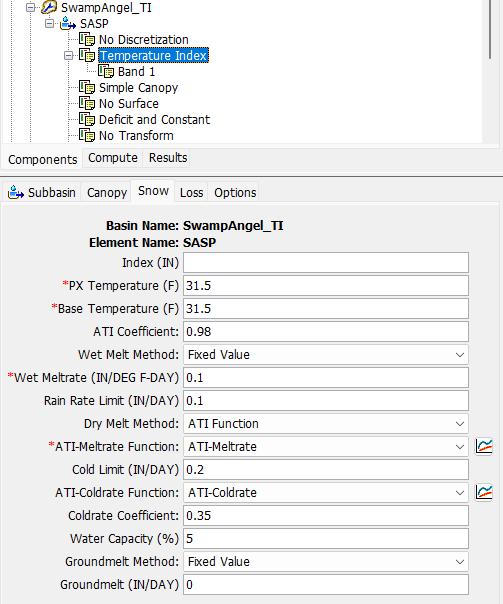
Initial Values
Each subbasin is broken into one or more Elevation Bands; each band has its own parameter data. One elevation band may be used to represent a subbasin with very little terrain variation. Subbasins with large elevation variations should use multiple elevation bands. Create an elevation band by clicking with the right mouse button on the Temperature Index icon under a subbasin as shown below. A context menu is displayed that allows you to create a new elevation band. You can also create an elevation band by clicking with the right mouse button on any existing elevation band. The same context menu is displayed that allows you to create a new elevation band. Delete an elevation band by clicking on it with the right mouse button. A context menu is displayed that allows you to delete the elevation band. Clicking on the elevation band icon will access the Component Editor used for each band.
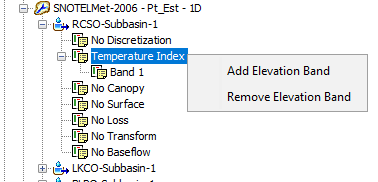
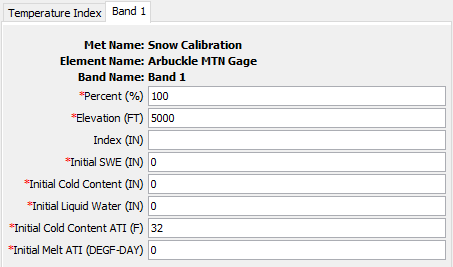
A Component Editor is provided for each Elevation Band where parameter data defines the Relative Size of the Band, the Elevation or the Band, and Initial Conditions for Snowpack in the Band. You must specify the Percentage of the Subbasin that each elevation band composes. An elevation band is not required to be contiguous. The percentage specified for each elevation band will automatically be normalized if the sum of the percentages across all subbasins does not equal 100. There is no limit to the number of elevation bands that can be used, but at least one is required. Typically only one band is used in watersheds with small elevation differences. Mountainous watersheds usually require several bands for each subbasin.
Enter the Average Elevation for each elevation band. Typically the specified elevation will be either the area-weighted elevation of the band, or the average of the highest and lowest points in the band.
The optional Precipitation Index must be entered in combination with an index value for the subbasin as a whole if you wish to adjust precipitation for each elevation band. In general, precipitation increases at higher elevations in mountainous watersheds.
The Initial Snow Water Equivalent (SWE) that exists at the beginning of the simulation must be entered. This information is usually determined by interpolating from actual measurements of snow water equivalent. This value can be set to zero if there is no snow.
The Initial Cold Content that exists at the beginning of the simulation must be entered. It represents the heat required to raise the temperature of the snow pack to 0° C (32° F) and is expressed as a number equivalent to mm (inches) of frozen water. If there is no snow at the beginning of the simulation, it can be set to zero. If there is a snowpack, it can be estimated as the depth of snow multiplied by the snow density multiplied by the heat capacity of snow multiplied by the number of degrees below the freezing point.
The Liquid Water Held Within the Snowpack at the beginning of the simulation must be entered. Liquid water can persist in the snow only if the snowpack temperature is at 0° C (32° F). There are few conditions when this value can be exactly known. One case is when there is no snowpack and it can be set to zero. A second case is when the air temperature has been continually below freezing for several days and it can be set to zero.
The Initial Cold Content Antecedent Temperature Index is an index to the snow temperature near the surface of the snowpack. It should be set to the approximate snowpack temperature at the beginning of the simulation. If the initial temperature is not known, it can be set to 0° C (32° F).
The seasonal variation of meltrate is indexed by an Antecedent Temperature Function. The initial meltrate ATI should be thought of as similar to "the accumulated thawing degree days." This antecedent temperature function allows the melt rate to change as the snowpack matures and ages. If there is no snow on the ground at the start of the simulation this term can be set to zero. It can also be set to zero if the simulation is starting during or at the end of a cold period when air temperatures were continually below the base temperature. Otherwise it must be calculated as the accumulation of degree-days since the last period of sustained air temperature below freezing.
Parameter Values
An optional Precipitation Index may be used. In order to use the index, it must be specified for the subbasin as a whole and also for each elevation band. The ratio of the index for the subbasin and the index at an elevation band is used to adjust the precipitation for each elevation band. Indexing is one method to adjust for orographic trends in precipitation.
The PX Temperature is used to discriminate between precipitation falling as rain or snow. When the air temperature is less than the specified temperature, any precipitation is assumed to be snow. When the air temperature is above the specified temperature, any precipitation is assumed to be rain.
The difference between the Base Temperature and the Air Temperature defines the Temperature Index used in calculating snowmelt. The meltrate is multiplied by the difference between the air temperature and the base temperature to estimate the snowmelt amount. If the air temperature is less than the base temperature, then the amount of melt is zero. Typically, the base temperature should be 0° C.
The Wet Meltrate is used during time intervals when precipitation is falling as rain, and the rainfall rate is greater than the rain rate limit. It represents the rate at which the snowpack melts when it is raining on the snowpack.
There are two options for specifying the Wet Melt Rate:
- Fixed value. A fixed value is used to calculate wet meltrate.
- Annual pattern. A meltrate pattern may be specified that defines the wet meltrate as a function of the time of year. The pattern must be specified separately in the Paired Data Manager before it can be used in the Snow Melt Method. The Paired Data Type should be Parameter Value Pattern with parameter Wet Melt Rate.
The Rain Rate Limit discriminates between dry melt and wet melt. The wet meltrate is applied as the meltrate when it is raining at rates greater than the rain rate limit. If the rain rate is less than the rain rate limit, the meltrate is computed as if there were no precipitation. The default value of 0 mm/day is used if no value is entered, meaning that even a trace of precipitation results in the use of the wet melt rate.
A meltrate must be calculated for time intervals when the precipitation rate is less than the rain rate limit. The calculation starts with the meltrate antecedent temperature index. A coefficient is used to update the antecedent meltrate index from one time interval to the next. The default value of 0.98 is used if no value is entered.
There are three options for specifying the Dry Melt Rate:
- ATI-Meltrate Function. An Antecedent Temperature Index Meltrate Function is used to calculate a meltrate from the current meltrate index. The function must be specified separately in the Paired Data Manager before it can be used in the snow melt method. The function should define appropriate meltrates to use over the range of meltrate index values that will be encountered during a simulation. The melt rate for dry conditions typically ranges from 1 to 4 mm/degC-day.
- Annual Pattern. A meltrate pattern may be specified that defines the dry meltrate as a function of the time of year. The pattern must be specified separately in the Paired Data Manager before it can be used in the Snow Melt Method. The Paired Data Type should be Parameter Value Pattern with parameter Dry Melt Rate.
- Fixed Value. A fixed value is used to calculate dry meltrate.
The Cold Limit accounts for the rapid changes in temperature that the snowpack undergoes during high precipitation rates. When the precipitation rate exceeds the specified cold limit, the antecedent cold content index is set to the temperature of the precipitation. If the temperature is above the base temperature, the cold content index is set to the base temperature. If the temperature is below the base temperature, the cold content index is set to the actual temperature. If the precipitation rate is less than the cold limit, the cold content index is computed as an antecedent index. The default value of 0mm/day is used if no value is entered, meaning that even a trace of snowfall will reset the cold content.
The Cold Content Antecedent Temperature Index Coefficient is used to update the antecedent cold content index from one time interval to the next. This is a separate index from the one used to update the meltrate index. A default value of 0.5 is used if no value is entered.
An Antecedent Temperature Index Cold Content Function is used to calculate a cold content from the current cold content index. The function must be specified separately in the Paired Data Manager before it can be used in the Snow Melt Method. The function should define appropriate cold contents to use over the range of cold content index values that will be encountered during a simulation. The cold rate typically ranges from 1.22 to 1.32 mm/degC-day.
The Maximum Liquid Water Capacity specifies the amount of melted water that must accumulate in the snowpack before liquid water becomes available at the soil surface for infiltration or runoff. Typically, the maximum liquid water held in the snowpack is on the order of 3%-5% of the snow water equivalent, although it can be higher. Liquid water can persist in the snow only if the snowpack temperature is at 0C; at which point the cold content is zero. The maximum is entered as a percentage of the snow water equivalent.
Heat from the Ground can cause snowmelt, especially if the snowpack accumulates on ground that is only partially frozen or completely unfrozen. In these cases the warm ground is insulated by the snowpack. Heat from the warm ground will cause the bottom of the snowpack to melt. Two methods are available for specifying the melting of the snowpack due to contact with unfrozen ground:
- A Fixed Value can be entered; the same amount of melt is computed for the snowpack regardless of atmospheric conditions above the pack or the time of year.
- An Annual Pattern can alternately be entered; the pattern specifies the meltrate due to contact with the ground as a function of the time of year. The pattern must be entered in the Paired Data Manager before is can be used in the snowmelt method. The Paired Data Type should be Parameter Value Pattern with parameter Ground Melt Rate.
Required Meteorologic Model Boundary Conditions
To use this method, an Air Temperature boundary condition must be selected in the Meteorologic Model linked to the basin model using the elevation band temperature index method.
Gridded Hybrid
The Gridded Hybrid Method, or Radiation-derived Temperature Index (RTI) Method, uses a radiation balance, rather than temperature, as a proxy for available energy in the snowpack (Follum et al., (2015). Measurements of solar radiation are rarely available and if available, they are typically point measurements. In the original RTI model, the incident shortwave radiation for each grid cell is adjusted by reduction factors for the distance from the earth to the sun, atmospheric scattering, absorption by clouds, vegetation, slope/aspect of the terrain, and topographic shading. The current implementation of the model within HEC-HMS does not include reduction factors for absorption by clouds or vegetation. The method is inherently gridded (there is no banded implementation in HEC-HMS). Starting in v4.12, this method can be used in conjunction with any precipitation, temperature, shortwave radiation, longwave radiation, air pressure, relative humidity, and/or land surface method. The Gridded Hybrid Method includes spatial variability in shortwave and longwave radiation and is therefore well-suited for watersheds with forests and steep terrain. The Gridded Hybrid Method includes a Component Editor with snow pack initial conditions and parameters for an individual subbasin element. You can open a global temperature index editor from the Parameters | Snowmelt menu.
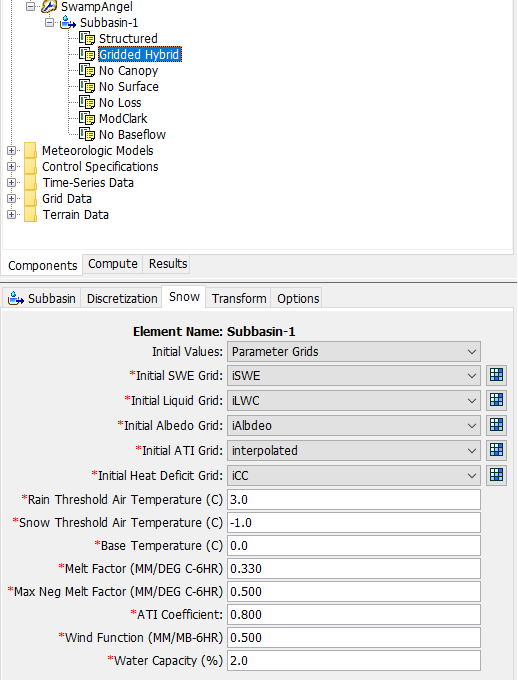
Terrain Preprocessing
Prior to computing a Simulation Run with the Gridded Hybrid snowmelt method, the Slope, Aspect, and Solar Shading of the terrain can be computed. To compute these parameters, expand the Terrain Data folder in the Watershed Explorer. Right click on the terrain and select Preprocess Slope and Aspect and Preprocess Solar Shading, as shown below.
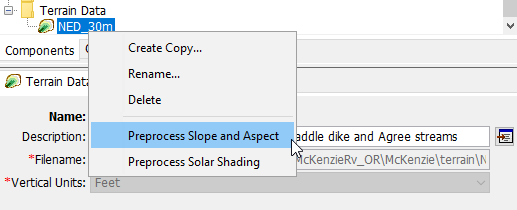
The user can specify a Solar Shading Search Radius over which solar shading computations are performed. When the distance between 2 grid cells exceeds the radius, cell 1 does not contribute to solar shading of cell 2 and solar shading computations are not computed. If the radius field is left blank, the program will consider all grid cells in the terrain when computing solar shading coefficients.
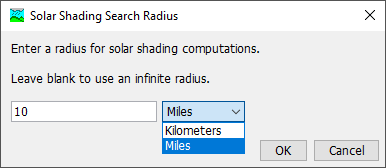
A shading coefficient of 1.0 indicates full sun with no terrain interference while a shading coefficient of 0.0 indicates complete blocking of sunlight.
Initial Values
The Initial Values can be specified with gridsets, or can be initialized to default values. All cells in each subbasin are set to the same default value when the Default Values option is chosen. The default values are:
- Initial SWE of 0 mm (0 in)
- Initial Liquid of 0%
- Initial Albedo of 0.4
- Initial ATI of 0°C (32°F)
- Initial Heat Deficit of 0 mm (0 in)
Five parameter grids must be selected when the Parameter Grids option is selected; the grids are described in the following paragraphs.
The Initial Snow Water Equivalent that exists at the beginning of the simulation must be entered. This information is usually determined by interpolating from actual measurements of snow water equivalent. This value can be set to zero if there is no snow. The Initial Snow Water Equivalent grid can be created within the Grid Data Manager by selecting the Snow Water Equivalent Grids data type.
The Initial Liquid at the beginning of the simulation must be entered. Liquid water can persist in the snow only if the snowpack temperature is at 0°C (32°F). There are few conditions when this value can be exactly known. One case is when there is no snowpack and it can be set to zero. A second case is when the air temperature has been continually below freezing for several days and it can be set to zero. The Initial Liquid grid can be created within the Grid Data Manager by selecting the Liquid Water Content Grids data type.
The Initial Albedo that exists at the beginning of the simulation must be represented. This information is usually obtained from simulated output. This value can be set to zero if there is no snow. The Initial Albedo grid can be created within the Grid Data Manager by selecting the Albedo Grids data type.
The Initial ATI that exists at the beginning of the simulation must be represented. This information is usually obtained from simulated output. This value can be set to zero if there is no snow. The Initial ATI grid can be created within the Grid Data Manager by selecting the Temperature Gridsets data type.
The Initial Heat Deficit at the beginning of the simulation must be entered. The heat deficit describes the net heat loss from the snowpack since the start of the simulation. The Initial Heat Deficit grid can be created within the Grid Data Manager by selecting the Cold Content Grids data type.
Parameter Values
The Rain Threshold Air Temperature and the Snow Threshold Air Temperature are used to discriminate between precipitation falling as rain or snow. When the air temperature is greater than the Rain Threshold Air Temperature, any precipitation is assumed to be rain. When the air temperature is less than the Snow Threshold Air Temperature, any precipitation is assumed to be snow. When the air temperature is between the two threshold temperatures, the amount of precipitation is partitioned between snowfall and rainfall based on the air temperature.
The Base Temperature is the temperature above which snow begins to melt. This parameter typically has a value around the freezing temperature, but can vary by a few degrees.
The Melt Factor is a coefficient used to calculate the melt. As a result, it impacts the rate of snow melt.
The Maximum Negative Melt Factor is used to calculate the heat deficit within the snowpack due to the difference between the air temperature and the snow surface temperature. Melt occurs when the energy input into the snowpack overcomes the heat deficit.
The Antecedent Temperature Index (ATI) Coefficient is used to calculate a temperature index from the current temperature index.
During melting periods, the air temperature is warmer than the snowpack surface temperature. The Wind Function is used to calculate the impediment of flow of vapor by this temperature gradient.
When the liquid water content in the snowpack exceeds the Water Capacity, water leaves the snowpack.
Tutorials describing example applications of this snowmelt method, including parameter estimation and calibration, can be found here: Calibrating Gridded Snowmelt: Upper Truckee River, California and Calibrating Point Snowmelt: Swamp Angel Study Plot, Colorado.
A tutorial illustrating how to use the Uncertainty Analysis to evaluate Hybrid Snow parameter sensitivity can be found here: Evaluating Gridded Hybrid/RTI Snowmelt Parameter Sensitivity.
More information on the mathematical calculations underpinning this method, in addition to minimum, maximum, and recommend parameter ranges, can be found here: Hybrid Snow section of the Technical Reference Manual.
Required Meteorologic Model Boundary Conditions
In addition to the Subbasin parameters, the following Meteorologic Model boundary conditions are required to use this method include:
- Incoming Shortwave Radiation
- Incoming Longwave Radiation
- Precipitation
- Air Temperature
- Atmospheric Pressure
- Relative Humidity
Gridded Energy Budget
The Gridded Energy Budget Method is the same as the Energy Budget Method except the equations for simulating the snowpack are computed separately for each grid cell with separate precipitation and temperature boundary conditions instead of area-averaged values over the whole subbasin. Starting in v4.12, this method can be used in conjunction with any precipitation, temperature, shortwave radiation, longwave radiation, air pressure, relative humidity, wind speed, and/or land surface method. The Gridded Energy Budget Method includes a Component Editor with snow pack initial conditions and energy budget parameters for an individual subbasin element. You can open a global temperature index editor from the Parameters | Snowmelt menu.
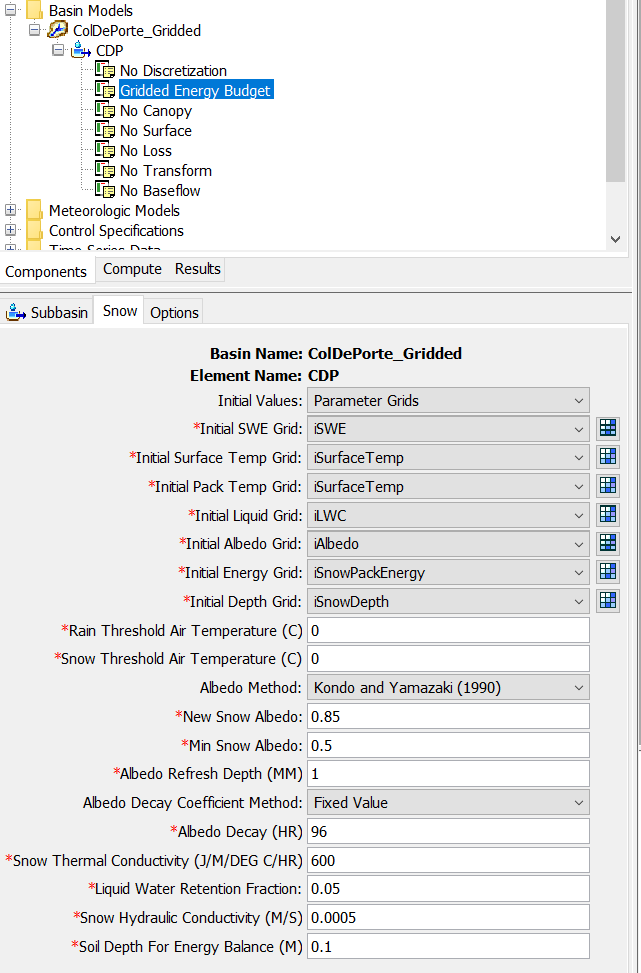
Terrain Preprocessing
Prior to computing a Simulation Run with the Gridded Energy Budget Method snowmelt method, the Slope, Aspect, and Solar Shading of the terrain can be computed. To compute these parameters, expand the Terrain Data folder in the Watershed Explorer. Right click on the terrain and select Preprocess Slope and Aspect and Preprocess Solar Shading.
The user can specify a Solar Shading Search Radius over which solar shading computations are performed. When the distance between 2 grid cells exceeds the radius, cell 1 does not contribute to solar shading of cell 2 and solar shading computations are not computed. If the radius field is left blank, the program will consider all grid cells in the terrain when computing solar shading coefficients.
A shading coefficient of 1.0 indicates full sun with no terrain interference while a shading coefficient of 0.0 indicates complete blocking of sunlight.
Initial Values
The Initial Values can be specified with gridsets, or can be initialized to default values. All cells in each subbasin are set to the same default value when the Default Values option is chosen. The default values are:
- Initial SWE of 0 mm (0 in)
- Initial Surface Temperature of 0°C (32°F)
- Initial Pack Temperature of 0°C (32°F)
- Initial Liquid of 0%
- Initial Albedo of 0.4
- Initial Energy of 0 J/m2 (0 BTU/ft2)
- Initial Depth of 0 mm (0 in)
Seven parameter grids must be selected when the Parameter Grids option is selected; the grids are described in the following paragraphs.
The Initial Snow Water Equivalent that exists at the beginning of the simulation must be entered. This information is usually determined by interpolating from actual measurements of snow water equivalent. This value can be set to zero if there is no snow. The Initial Snow Water Equivalent grid can be created within the Grid Data Manager by selecting the Snow Water Equivalent Grids data type.
The Initial Surface Temperature that exists at the beginning of the simulation must be entered. This information is usually obtained from simulated output. This value can be set to zero if there is no snow. The Initial Surface Temperature grid can be created within the Grid Data Manager by selecting the Temperature Gridsets data type.
The Initial Pack Temperature at the beginning of the simulation must be entered. The Initial Pack Temperature grid can be created within the Grid Data Manager by selecting the Temperature Gridsets data type.
The Initial Liquid at the beginning of the simulation must be entered. Liquid water can persist in the snow only if the snowpack temperature is at 0°C (32°F). There are few conditions when this value can be exactly known. One case is when there is no snowpack and it can be set to zero. A second case is when the air temperature has been continually below freezing for several days and it can be set to zero. The Initial Liquid grid can be created within the Grid Data Manager by selecting the Liquid Water Content Grids data type.
The Initial Albedo that exists at the beginning of the simulation must be represented. This information is usually obtained from simulated output. This value can be set to zero if there is no snow. The Initial Albedo grid can be created within the Grid Data Manager by selecting the Albedo Grids data type.
The Initial Energy that exists at the beginning of the simulation must be represented. This information is usually obtained from simulated output. This value can be set to zero if there is no snow. The Initial Energy grid can be created within the Grid Data Manager by selecting the Energy Grids data type.
The Initial Depth of snow at the beginning of the simulation must be entered. This information is usually determined by interpolating from actual measurements of snowpack depth. This value can be set to zero if there is no snow. The Initial Depth grid can be created within the Grid Data Manager by selecting the Snow Depth Grids data type.
Parameter Values
The Rain Threshold Air Temperature and the Snow Threshold Air Temperature are used to discriminate between precipitation falling as rain or snow. When the air temperature is greater than the Rain Threshold Air Temperature, any precipitation is assumed to be rain. When the air temperature is less than the Snow Threshold Air Temperature, any precipitation is assumed to be snow. When the air temperature is between the two threshold temperatures, the amount of precipitation is partitioned between snowfall and rainfall based on the air temperature.
Currently, only the Kondo and Yamazaki (1990) option is available for the Albedo Method. Additional options will be added in the future.
The New Snow Albedo describes the reflectivity of newly fallen snow and typically has a value of 0.8-0.95.
The Minimum Snow Albedo describes the lower limit of the reflectivity of the snow. The minimum snow albedo typically has a value of 0.2-0.5.
The Albedo Refresh Depth is the depth of fresh snow required to reset the albedo to the New Snow Albedo value.
The Albedo Decay is a coefficient used in an exponential decay function to describe the decrease in the albedo as the snowpack ages.
There are two methods for specifying the Albedo Decay Coefficient:
- Fixed value. A fixed value is used.
- Annual pattern. An albedo decay coefficient pattern may be specified that defines the albedo decay coefficient as a function of the time of year. The pattern must be specified separately in the Paired Data Manager before it can be used in the Snow Melt Method. The Paired Data Type should be Parameter Value Pattern with parameter Albedo Decay Coefficient.
The Snow Thermal Conductivity describes the snow's ability to conduct heat and is used to calculate the snowpack surface temperature flux. When the snowpack is shallow (i.e. less than the effective depth over which the temperature gradient acts), an adjustment is applied to the thermal conductivity.
The Liquid Water Retention Fraction is used to compute the portion of energy content held as liquid water in the snowpack.
The Snow Hydraulic Conductivity is used to calculate the liquid water content of the snowpack in Darcy's law for flow through porous media.
The Soil Depth for Energy Balance is the depth of soil that interacts thermally with the snowpack.
A tutorial and guide detailing the relative sensitivity of these parameters for a location in Colorado can be found here: Evaluating Energy Budget Snowmelt Parameter Sensitivity.
Required Meteorologic Model Boundary Conditions
In addition to the Subbasin parameters, the following Meteorologic Model boundary conditions are required to use this method include:
- Incoming Shortwave Radiation
- Incoming Longwave Radiation
- Precipitation
- Air Temperature
- Wind Speed
- Atmospheric Pressure
- Relative Humidity
Energy Budget
The Energy Budget Method is based on the Utah Energy Balance (UEB) model (Tarboton and Luce, 1996; Luce, 2000; Tarboton and Luce, 2001; You, 2004). The UEB snowmelt model is a physically-based energy and mass balance model. Energy is exchanged between the snowpack, the air above, and the soil below. The model represents the snowpack using a single layer and includes the upper part of the ground which has thermal interaction with the snowpack. An energy balance is computed for the snowpack surface to get the snowpack surface temperature. The snowpack surface temperature is then used to compute the change in snowpack energy content over a time interval. The mass balance includes rainfall rate, snowfall rate, meltwater outflow from the snowpack, and vapor transport between the snowpack and the atmosphere. Snowpack condensation describes vapor transport from the atmosphere to the snowpack. Snowpack sublimation describes vapor transport from the snowpack to the atmosphere. The current implementation of the model within HEC-HMS does not include reduction factors for absorption by clouds or forest cover.
The Energy Budget Method includes a Component Editor with parameter data. Each subbasin must have at least one elevation band and may have up to ten elevation bands. A separate Component Editor is included for each elevation band. A Component Editor for the elevation band energy budget method is shown below.
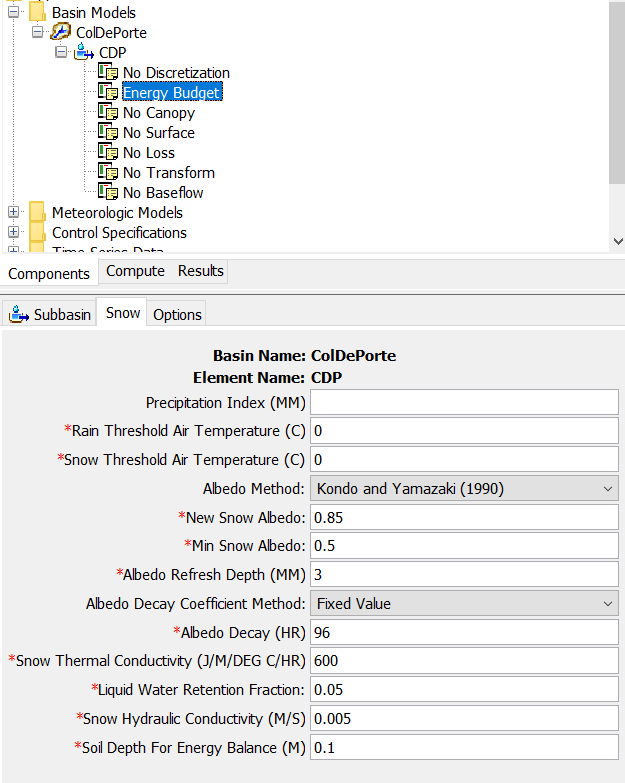
Initial Values
Each subbasin is broken into one or more Elevation Bands; each band has its own parameter data. One elevation band may be used to represent a subbasin with very little terrain variation. Subbasins with large elevation variations should use multiple elevation bands. Create an elevation band by clicking with the right mouse button on the Energy Budget icon under a subbasin as shown below. A context menu is displayed that allows you to create a new elevation band. You can also create an elevation band by clicking with the right mouse button on any existing elevation band. The same context menu is displayed that allows you to create a new elevation band. Delete an elevation band by clicking on it with the right mouse button. A context menu is displayed that allows you to delete the elevation band. Clicking on the elevation band icon will access the Component Editor used for each band.

A Component Editor is provided for each Elevation Band where parameter data defines the Relative Size of the Band, the Elevation or the Band, and Initial Conditions for Snowpack in the Band.
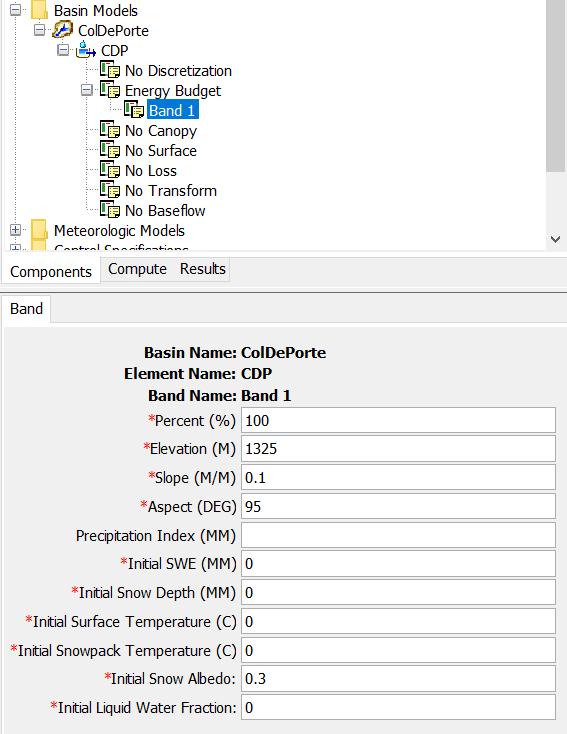
You must specify the Percentage of the Subbasin that each elevation band composes. An elevation band is not required to be contiguous. The percentage specified for each elevation band will automatically be normalized if the sum of the percentages across all subbasins does not equal 100. There is no limit to the number of elevation bands that can be used, but at least one is required. Typically only one band is used in watersheds with small elevation differences. Mountainous watersheds usually require several bands for each subbasin.
Enter the Average Elevation for each elevation band. Typically the specified elevation will be either the area-weighted elevation of the band, or the average of the highest and lowest points in the band.
Enter the Average Slope for each elevation band. Typically the specified slope will be either the area-weighted slope of the band, or the average of the steepest and flattest points in the band.
Enter the Average Aspect for each elevation band. Aspect is the predominant downhill direction, oriented clockwise from North. Typically the specified aspect will be either the area-weighted aspect of the band.
The optional Precipitation Index must be entered in combination with an index value for the subbasin as a whole if you wish to adjust precipitation for each elevation band. In general, precipitation increases at higher elevations in mountainous watersheds.
The Initial Snow Water Equivalent (SWE) that exists at the beginning of the simulation must be entered. This information is usually determined by interpolating from actual measurements of snow water equivalent. This value can be set to zero if there is no snow.
The Initial Snow Depth that exists at the beginning of the simulation must be entered. This information is usually determined by interpolating from actual measurements of snow depth. This value can be set to zero if there is no snow.
The Initial Surface Temperature that exists at the beginning of the simulation must be entered. This information is usually determined by interpolating from actual measurements of surface temperature. This value can be set to zero if there is no snow.
The Initial Snowpack Temperature that exists at the beginning of the simulation must be entered. This information is usually determined by interpolating from actual measurements of snowpack temperature. This value can be set to zero if there is no snow.
The Initial Albedo that exists at the beginning of the simulation must be entered. This information is usually obtained from simulated output. This value can be set to zero if there is no snow.
The Initial Liquid at the beginning of the simulation must be entered. Liquid water can persist in the snow only if the snowpack temperature is at 0°C (32°F). There are few conditions when this value can be exactly known. One case is when there is no snowpack and it can be set to zero. A second case is when the air temperature has been continually below freezing for several days and it can be set to zero.
Parameter Values
The Rain Threshold Air Temperature and the Snow Threshold Air Temperature are used to discriminate between precipitation falling as rain or snow. When the air temperature is greater than the Rain Threshold Air Temperature, any precipitation is assumed to be rain. When the air temperature is less than the Snow Threshold Air Temperature, any precipitation is assumed to be snow. When the air temperature is between the two threshold temperatures, the amount of precipitation is partitioned between snowfall and rainfall based on the air temperature.
Currently, only the Kondo and Yamazaki (1990) option is available for the Albedo Method. Additional options will be added in the future.
The New Snow Albedo describes the reflectivity of newly fallen snow and typically has a value of 0.8-0.95.
The Minimum Snow Albedo describes the lower limit of the reflectivity of the snow. The minimum snow albedo typically has a value of 0.2-0.5.
The Albedo Refresh Depth is the depth of fresh snow required to reset the albedo to the New Snow Albedo value.
The Albedo Decay is a coefficient used in an exponential decay function to describe the decrease in the albedo as the snowpack ages.
There are two methods for specifying the Albedo Decay Coefficient:
- Fixed value. A fixed value is used.
- Annual pattern. An albedo decay coefficient pattern may be specified that defines the albedo decay coefficient as a function of the time of year. The pattern must be specified separately in the Paired Data Manager before it can be used in the Snow Melt Method. The Paired Data Type should be Parameter Value Pattern with parameter Albedo Decay Coefficient.
The Snow Thermal Conductivity describes the snow's ability to conduct heat and is used to calculate the snowpack surface temperature flux. When the snowpack is shallow (i.e. less than the effective depth over which the temperature gradient acts), an adjustment is applied to the thermal conductivity.
The Liquid Water Retention Fraction is used to compute the portion of energy content held as liquid water in the snowpack.
The Snow Hydraulic Conductivity is used to calculate the liquid water content of the snowpack in Darcy's law for flow through porous media.
The Soil Depth for Energy Balance is the depth of soil that interacts thermally with the snowpack.
Required Meteorologic Model Boundary Conditions
To use this method, the following boundary conditions must be selected in the Meteorologic Model linked to the Basin Model using the elevation band energy budget method:
- Incoming Shortwave Radiation
- Incoming Longwave Radiation
- Precipitation
- Air Temperature
- Wind Speed
- Atmospheric Pressure
- Relative Humidity